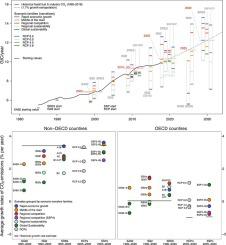Global Environmental Change ( IF 8.9 ) Pub Date : 2020-12-10 , DOI: 10.1016/j.gloenvcha.2020.102199 Jiesper Strandsbjerg Tristan Pedersen , Filipe Duarte Santos , Detlef van Vuuren , Joyeeta Gupta , Ricardo Encarnação Coelho , Bruno A. Aparício , Rob Swart

|
Long-term emissions scenarios have served as the primary basis for assessing future climate change and response strategies. Therefore, it is important to regularly reassess the relevance of emissions scenarios in light of changing global circumstances and compare them with long-term developments to determine if they are still plausible, considering the newest insights. Four scenario series, SA90, IS92, SRES, and RCP/SSP, were central in the scenario-based literature informing the five Assessment Reports of the Intergovernmental Panel on Climate Change (IPCC) and the sixth assessment cycle. Here we analyze the historical trends of carbon dioxide (CO2) emissions from fossil fuel combustion and industry and emissions drivers between 1960 and 2017. We then compare the emission scenario series with historical trends for the period 1990–2017/2018. The results show that historical trends are quite consistent with medium scenarios in each series. As a result, they can be regarded as valid inputs for past and future analyses of climate change and impacts. Global CO2 emissions 1960–2018 (and 1990–2018) comprised six (and three) overall subperiods of emissions growth significantly higher and lower than average. Historically, CO2 emissions (in absolute numbers and growth rate) are tightly coupled with primary energy and indirectly with GDP. Global emissions generally followed a medium-high pathway, captured by “middle-of-the-road” scenario narratives in the earlier series, and by combinations of “global-sustainability” and “middle-of-the-road” narratives in the most recent series (SRES and SSP-baselines). Historical non-OECD trends were best captured by “rapid-growth” and “regional-competition” scenarios, while OECD trends were close to regional-sustainability and global-sustainability scenarios. Areas where the emissions scenarios captured the historical trends less well, are renewable and nuclear primary energy supply. The fact that the actual historical development is consistent with rapid-growth narratives in the non-OECD regions might have important implications for future greenhouse gas emissions and associated climatic change.
中文翻译:

针对IPCC报告针对全球历史排放情景预测的绩效评估
长期排放情景已成为评估未来气候变化和应对策略的主要基础。因此,重要的是要根据不断变化的全球环境定期重新评估排放情景的相关性,并将其与长期发展进行比较,以考虑最新的见解来确定它们是否仍然合理。在基于情景的文献中,有四个情景系列,即SA90,IS92,SRES和RCP / SSP,处于中心地位,这些资料通知了政府间气候变化专门委员会(IPCC)的五份评估报告和第六个评估周期。在这里,我们分析了1960年至2017年间化石燃料燃烧和工业产生的二氧化碳(CO2)排放的历史趋势以及排放驱动因素。然后,我们将排放情景序列与1990–2017 / 2018年的历史趋势进行了比较。结果表明,历史趋势与每个系列的中等情景非常一致。因此,它们可以被视为过去和将来对气候变化和影响的分析的有效输入。1960–2018年(和1990–2018年)的全球CO2排放量包括六个(和三个)排放量总体上高于和低于平均水平的子时期。从历史上看,二氧化碳的排放量(绝对数量和增长率)与一次能源紧密相关,而与GDP间接相关。全球排放总体上遵循中高路径,被早期系列中的“道路中间”情景描述,以及全球排放量中“全球可持续性”和“道路中间”情景的组合所捕获。最新系列(SRES和SSP基准)。非经济合作与发展组织的历史趋势最好通过“快速增长”和“区域竞争”情景来把握,而经济合作与发展组织趋势则接近区域可持续性和全球可持续性情景。排放情景无法很好地反映历史趋势的地区是可再生能源和核一次能源供应。实际的历史发展与非经合组织地区的快速增长的叙述相吻合的事实可能对未来的温室气体排放和相关的气候变化具有重要意义。


























 京公网安备 11010802027423号
京公网安备 11010802027423号